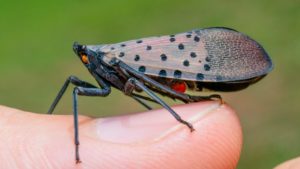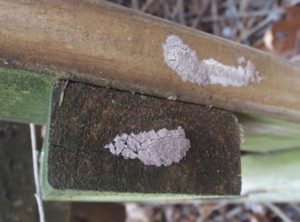
The adult spotted lanternfly is a pest to be on the lookout for this year. Photo from University of Maryland’s Home and Garden Information Center.
The spotted lanternfly (SLF) is an invasive species that has spread throughout the Mid-Atlantic region, including Maryland, Pennsylvania, and Delaware. This year the spotted lanternfly is more prominent, and the time to treat this pest is now. But what does this pest do, and why is it essential to remove it from your landscape? Call Scientific Plant Service today if you need help combating this harmful pest.
Damage Caused By The Spotted Lanternfly
The spotted lanternfly feeds on the plant sap of many different plants and can be a terrible nuisance for anyone hoping to enjoy the outdoors. The spotted lanternfly uses its piercing-sucking mouthpart to feed on sap from as many as 70 different plant species. It, unfortunately, tends to prefer economically important plants like grapevines, black walnut, maple trees, birch, willow, and other notable tree species. The damage caused by their feeding stresses the plants so significantly that their health greatly suffers.
Additionally, as the spotted lanternfly feeds, it excretes honeydew, a sugary substance that attracts bees, wasps, and other troublesome insects. The honeydew can further build up and promote the growth of sooty mold (fungi), which covers and stains the plant and everything under it. The sooty mold is so heavy that photosynthesis is severely reduced.
How to Recognize the Spotted Lanternfly

Spotted lanternfly egg masses left behind on hard wood surfaces. Photo from University of Maryland’s Home and Garden Information Center.
Lanternflies have one generation per year consisting of four nymphal stages, an adult stage, and overwintering as egg masses. These stages all look different. Here’s how to spot this pest:
- Egg Masses: The spotted lanternfly lays egg masses about one inch long on hard surfaces including trees, stones, and even patio furniture. The egg masses are covered in a white putty-like substance, which can appear to look like cracked mud over time.
- Old Egg Masses: The mud-like covering has worn off, and you can see the individual seed-like eggs on the surface.
- Early-Stage Nymphs: These hatch from the eggs and are only a few millimeters long. As they age, they reach about ¼”. The nymphs have black bodies and legs and are covered in bright white spots. They will jump when prodded or frightened.
- Late-Stage Nymphs: These nymphs are about ½” long, bright red, and covered in black stripes and white spots. They will also jump if prodded.
- Adults: The adult spotted lanternflies are about 1” long, have large wings, and can fly, although they prefer to jump and glide.
The spotted lanternflies will move up and down the tree in groups so that movement can be quite noticeable.
Treat Your Landscape Now
The spotted lanternfly eggs start hatching in May and June. It’s best to control these pests now before they grow to adulthood by the end of the summer and lay their eggs in the fall.
Without effective control these pests will often overtake the landscape, reducing the landscape’s health, and make the area inhospitable for family activities.
Scientific Plant Service Is Your Go-To Source In Landscape Healthcare
Scientific Plant Service, located in Baltimore, is a privately owned corporation, chartered in Maryland in 1957 by Frank J. Burke. We started as a full-service Arborists specializing in the care of shade trees and ornamental shrubs, but today we are a Lawn Care company that is a huge part of the community. From aquatic environments and snow management to deer and mole control, SPS has services tailored specifically for your lawn and landscape.
We offer services in Maryland, Washington, DC, and Virginia, including: Harford, Baltimore, Carroll, Frederick, Howard, Anne Arundel, Montgomery, Prince Georges, Talbot, Queen Anne’s, Calvert counties in MD, as well as Loudoun County, Fairfax County, Arlington, Alexandria, and Falls Church in VA. For more information, contact us online, or call us at 410-321-0970. Be sure to follow us on Facebook, Twitter, LinkedIn, and Pinterest.

